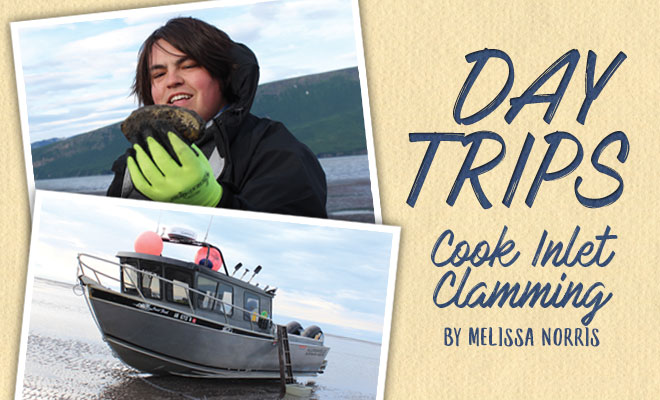 Razor Clam Digging in West Cook Inlet
Razor Clam Digging in West Cook Inlet
The days of abundance for razor clams at Kenai Peninsula drive-to locations are, at least for now, behind us, but there are great opportunities to charter a boat or take a DIY trip for west side Cook Inlet clam digging. We met Captain Ernie Kirby and his son Captain Bryan Kirby from Bottom Line Charters at the Deep Creek boat launch bright and early last July 11th. Captain Ernie had told me it was a razor-clam digging day based on the tides. I asked him about any clamming gear they recommended we test for this year’s Annual Gear Guide. That’s when Ernie told me about Clam Hawk, a quality clam gun made from a stainless-steel tube and PVC handle. Bottom Line Charters has extra clam guns, shovels, and buckets but you can also bring your own gear.
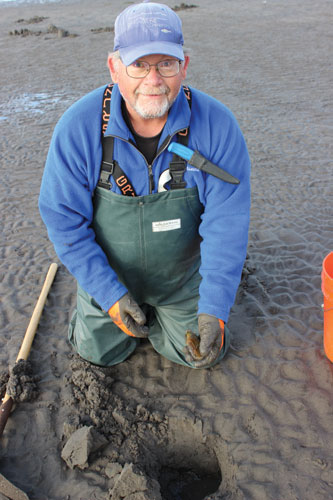
Captain Ernie shows us how to use the clam shovel. © Melissa Norris
The Fish Alaska crew included Mele, Russell, and I. We had our hearts set on harvesting razor clams to add to our bounty of Alaska seafood and for making recipes like my dad’s linguine and clam sauce, fried clams, clam chowder, and clam dip. We climbed a ladder to board the Alumaweld 28-foot Offshore Hardtop Just Fish, stowed our day packs, and settled in to experience the unique tractor-driven boat launch out of Deep Creek.
The trip across Cook Inlet from Deep Creek to the west-side beach to dig for clams is a roughly 28-mile trip that can take from 60- to 80 minutes depending on ocean conditions. There was chop on Cook Inlet that day which made for a little longer travel time. The sights along the way can include the volcanoes Mt. Augustine, Mt. Iliamna, and Mt. Redoubt, as well as some sea life, including otters and birds. Redoubt could be seen directly in front of us.
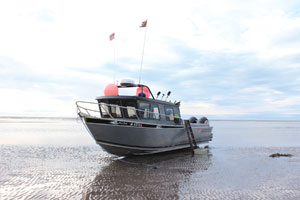
The ‘Just Fish’ when the tide is out. © Melissa Norris
Arriving at our destination about eight miles south of Polly Creek, Captain Bryan dropped anchor. The outgoing tide soon revealed the sandy beach we’d dig. The ladder came out again to get off the boat. The clock officially began ticking until the tide came back approximately four- to five hours later.
Bryan and Mele paired up and started looking for signs of clams called a “show.” Mele is a hands-on learner and she had a razor clam out of the ground in no time. “We are in Alaska because my husband is stationed here with the Coast Guard,” said Mele Wong, “Clamming was one of the Alaska experiences I wanted to check-off before our Summer 2019 move, and it certainly did not disappoint. Bryan was a gracious and patient teacher pinpointing the “rosettes” in the sand denoting the presence of a razor clam beneath. He demonstrated the best way to use the clam gun to extract the clam in one piece. In a matter of time, I was on a roll, digging up clams left and right all by myself. It was a really neat experience that gave me a whole new appreciation for fresh clams.”
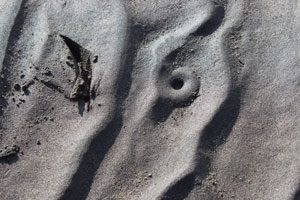
Clam “show”. © Melissa Norris
Bryan also showed Russell how to use the clam gun, then Ernie led Russell and I around the beach until we could identify the various types of “shows” clams make when they withdraw their necks from the sand. Ernie also demonstrated the art of using a clam shovel. The gun was easier for us as it was a sandy beach without much gravel and rock. Russell and I took turns using the gun and dropping clams in the bucket. We tested the 5-inch-diameter model of the Clam Hawk. With its 37-inch barrel, the gun saves you from having to bend over completely. We scouted for clam sign. The bucket began to fill up with razor clams and the occasional butter clam.
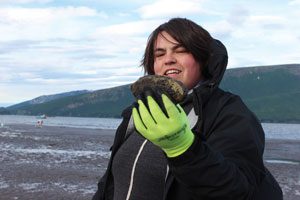
Russell jumped right in and used the ClamHawk gun to harvest a load of clams. © Melissa Norris
Razor clam limits in this area are nonexistent but that doesn’t mean we planned to take any more than we’d use. You can also currently take a limit of 80 per day, 80 in possession in combination of littleneck and butter clams where we were digging. We didn’t come anywhere near that and took a majority of razors.
Razor clam harvesting is closed in Cook Inlet from the mouth of the Kenai River south to the tip of the Homer Spit including popular places like Clam Gulch. The reason for the reduction in clam stocks in these areas is not known but it could be a combination of heavy surf, habitat changes, environmental stressors, as well as predation, according to the Alaska Department of Fish & Game. The west side of Cook Inlet remains open and while the west part of the inlet is not easily accessible, we still intended to harvest only what we’d use.
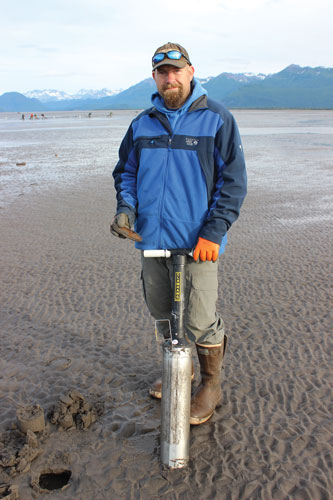
Captain Brian wish his well-used clam gun. © Melissa Norris
As the tide began to come back in Captain Ernie and Captain Bryan gathered the group to board the Just Fish. It was nearing lunch, so after Ernie and Bryan worked together to rinse the clams with saltwater and stow them for the trip back to Deep Creek, they brought out the barbecue grill and fixed burgers and hot dogs for the group. Instead of beelining back to the launch to end our trip, they shared a scenic ride past the Old Snug Harbor Cannery and showed off the bird rookery.
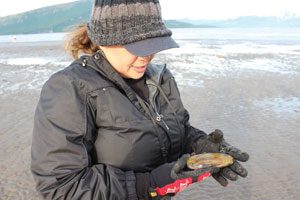
Mele has a new appreciation for fresh clams after pulling them out of the ground plus cleaning them. © Melissa Norris
It was a great day out on the ocean. The weather was nice and the company pleasant. Russell said the experience was really fun and the time just flew past. It seemed much shorter than the 10-hour day before returning to the launch. He was impressed with how knowledgeable and helpful our captains were from Bottom Line Charters. We all agreed the hard work started when we got back to our camp and spent hours to clean all the clams. We even had help from Mele’s husband Ryan, but it still took three hours to shell and clean the 2½ buckets of clams we took for our three households. For a step-by-step guide on how to clean razor clams and to check out my dad’s delicious linguine with clam sauce recipe, visit FishAlaskaMagazine.com.
Razor-clam digging isn’t all Bottom Line Charters is about. They are prolific anglers targeting halibut, salmon, and bottomfish from Ninilchik. You can book a trip to target one species or a combination. They primarily jig for halibut and bottomfish and troll or mooch for salmon. They also provide bear-viewing excursions. As mentioned, it’s a family affair with father and son as the primary captains. Bryan’s wife Dionne runs the ground operations and their son Hunter is learning the life to become the third generation of Kirby captains. Book your clam-digging event or a fun, freezer-filling mission with Bottom Line Charters.
“For all the different adventures we offer, we strive for safety, and an enjoyable and successful experience for guests,” said Captain Ernie.You can see them at the Great Alaska Sportsman Show this month, call 907-567-7366, or find them online at bottomlinecharters.us.
Melissa Norris is Publisher of Fish Alaska and Hunt Alaska magazines. She feels privileged and grateful for all the amazing trips she and her family have gotten to enjoy around Alaska.
This blog originally appeared as part of the Alaska Traveler column in the April 2019 issue of Fish Alaska.
